Сорбционная способность полимера на основе карбоксиметилцеллюлозы и глицидилакрилата по отношению к ионам металлов
- Авторы: Липина В.А.1, Евдокимова А.Н.1, Петрова Ю.А.1, Эрнандес Гарсиа Д.Д.1, Красанов И.В.2, Дмитриева А.В.2, Ситникова В.Е.3
-
Учреждения:
- Высшая школа технологии и энергетики Санкт-Петербургского государственного университета промышленных технологий и дизайна
- Санкт-Петербургский государственный морской технический университет
- Национальный исследовательский университет ИТМО
- Выпуск: Том 99, № 7 (2025)
- Страницы: 1094-1101
- Раздел: ФИЗИЧЕСКАЯ ХИМИЯ ДИСПЕРСНЫХ СИСТЕМ И ПОВЕРХНОСТНЫХ ЯВЛЕНИЙ
- Статья получена: 17.10.2025
- Статья опубликована: 15.07.2025
- URL: https://vestnik.nvsu.ru/0044-4537/article/view/693651
- DOI: https://doi.org/10.7868/S3034553725070151
- ID: 693651
Цитировать
Полный текст
Аннотация
Ключевые слова
Об авторах
В. А. Липина
Высшая школа технологии и энергетики Санкт-Петербургского государственного университета промышленных технологий и дизайнаСанкт-Петербург, Россия
А. Н. Евдокимова
Высшая школа технологии и энергетики Санкт-Петербургского государственного университета промышленных технологий и дизайнаСанкт-Петербург, Россия
Ю. А. Петрова
Высшая школа технологии и энергетики Санкт-Петербургского государственного университета промышленных технологий и дизайна
Email: yulia.petrova1997@yandex.ru
Санкт-Петербург, Россия
Д. Д. Эрнандес Гарсиа
Высшая школа технологии и энергетики Санкт-Петербургского государственного университета промышленных технологий и дизайнаСанкт-Петербург, Россия
И. В. Красанов
Санкт-Петербургский государственный морской технический университетСанкт-Петербург, Россия
А. В. Дмитриева
Санкт-Петербургский государственный морской технический университетСанкт-Петербург, Россия
В. Е. Ситникова
Национальный исследовательский университет ИТМОСанкт-Петербург, Россия
Список литературы
- van der Perk M. // Soil and Water Contamination (2nd ed.). London: CRC Press, 2017. 428 р.
- Tamez C., Hernandez R., Parsons. J.G. // Microchem. J. 2016. V. 125. P. 97. https://doi.org/10.1016/j.microc.2015.10.028
- Ntimbani R.N., Simate G.S., Ndlovu S. // J. Environ. Chem. Eng. 2015. V. 3. № 2. P. 1258. https://doi.org/10.1016/j.jece.2015.02.010
- Martin-Lara M.A., Blazquez G., Calero M. et al. // Int. J. Miner. Process. 2016. V. 148. P. 72. https://doi.org/10.1016/j.minpro.2016.01.017
- Ayala-Cabrera J.F., Trujillo-Rodriguez M.J., Pino V. et al. // Int. J. Environ. Anal. Chem. 2016. V. 96. № 2. P. 101. https://doi.org/10.1080/03067319.2015.1128538
- Xu Z., Gao G., Pan B. et al. // Water Res. 2015. V. 87. P. 378. https://doi.org/10.1016/j.watres.2015.09.025
- Bojic A.L., Bojic D., Andjelkovic T. // J. Hazard. Mater. 2009. V. 168. № 2. P. 813. https://doi.org/10.1016/j.jhazmat.2009.02.096
- Duan L., Hu N., Wang T. et al. // Chem. Eng. Commun. 2016. V. 203. № 1. P. 28. https://doi.org/10.1080/00986445.2014.956735
- Bailey S.E., Olin T.J., Bricka R.M., Adrian D.D. // Water Res. V. 33. № 11. P. 2469. https://doi.org/10.1016/s0043-1354(98)00475-8
- Altinisik A., Yurdakoc K. // Water Treat. 2015. V. 2. P. 994. https://doi.org/10.1080/19443994.20151091
- Rao G.P., Lu C., Su F. // Sep. Purif. Technol. 2007. V. 58. P. 224. https://doi.org/10.1016/j.seppur.2006.12.006
- Hu K., Wang K., Liu J., Dong Q. // Desalin. Water Treat. 2016. V. 57. № 10. P. 4606. https://doi.org/10.1080/19443994.2014.1001442
- Pawar R.R., Lalhmunsiama A., Bajaj H., Lee S.-M. // J. Ind. Eng. Chem. 2016. V. 34. P. 213. https://doi.org/10.1016/j.jiec.2015.11.014
- Sharma N., Tiwari A. // Desalin. Water Treat. 2016. V. 57. № 10. P. 4523. https://doi.org/10.1080/19443994.2014.991945
- Cheung W., Ng J., Mckay G. // J. Chem. Technol. Biotechnol. 2003. V. 78. P. 562. https://doi.org/10.1002/jctb.836
- Alshahateet S.F., Jiries A.G., Al-Trawneh S.A. et al. // Desalin. Water Treat. 2016. V. 57. № 10. P. 4512. https://doi.org/10.1080/19443994.2014.991762
- Neagu V., Mikhalovsky. S. // J. Hazard. Mater. 2010. V. 183. № 1. P. 533. https://doi.org/10.1016/j.jhazmat.2010.07.057J
- Rutkowska J., Kilian K., Pyrzynska K. // Eur. Polym. J. 2008. V. 44. № 7. P. 2108. https://doi.org/10.1016/j.eurpolymj.2008.04.009
- Uguzdogan E., Denkbaş E.B., Kabasakal O.S. // J. Hazard. Mater. 2010. V. 177. № 1. P. 119. https://doi.org/10.1016/j.jhazmat.2009.12.004
- El-Sakhawy M., Kamel S., Salama A., Sarhan H.-A. // J. Drug. Deliv. 2014. V. 2014. Article ID575969. https://doi.org/10.1155/2014/575969
- Lawniczak J.E., Posey-Dowty J., Seo K.S., Walker K. // Paint Coat. Ind. 2003. V. 19. № 6. P. 28.
- Posey-Dowty J.D., Seo K.S., Walker K.R., Wilson A.K. // Surf. Coat. Int. Part B: Coat. Trans. 2002. V. 85. № 3. P. 203. https://doi.org/10.1007/BF02699510
- McCreight K.W., Webster D.C., Kemp L.K. Patent US20050203278 A1 (2005).
- Shelton M.C., Wilson A.K., Posey-Dowty J.D. et al. Patent EP 1603953 (2007).
- Elwakeel K.Z., Rekaby M. // J. Hazard. Mater. 2011. V. 188. № 1–3. P. 10. https://doi.org/10.1016/j.jhazmat.2011.01.003
- Sandic Z.P., Nastasovic A.B., Jovic-Jovicic N.P. et al. // J. Appl. Polym. Sci. 2011. V. 121. № 1. P. 234. https://doi.org/10.1002/app.33537
- Chen C., Chiang C., Chen C.R. // Sep. Purif. Technol. 2007. V. 54. № 3. P. 396. https://doi.org/10.1016/j.seppur.2006.10.020
- Liu C., Bai R., Hong L., Liu T. // J. Colloid. Interface Sci. 2010. V. 345. № 2. P. 454. https://doi.org/10.1016/j.jcis.2010.01.057
- Евдокимов А.Н., Курзин А.В., Липин В.А. и др. // Бутлеровские сообщения. 2023. Т. 76. № 12. C. 167. https://doi.org/10.37952/ROI-jbc-01/23-76-12-167
- Филиппов Д.В., Фуфаева В.А., Шепелев М.В. // Журн. неорган. химии. 2022. Т. 67. № 3. С. 397. https://doi.org/10.31857/S0044457X22030084 [Filippov D.V., Fufaeva V.A., Shepelev M.V. // Russ. J. Inorg. Chem. 2022. V. 67. № 3. Р. 375. https://doi.org/10.1134/S0036023622030081]
- Farah A., Razak A.S., Zularisam A.W. et al. // Cleaner Waste Systems. 2022. V. 3. Article ID100051. https://doi.org/10.1016/j.clwas.2022.100051
- Itodo A.U., Itodo H.U. // Life Sci. J. 2010. V. 7. № 4. P. 31. https://doi.org/10.7537/marslsj070410.05
- Hsieh C.-T., Teng H. // J. Chem. Technol. Biotechnоl. 2000. V. 75. № 11. Р. 1066. https://doi.org/10.1002/1097-4660(200011)75:11<1066:: aid-jctb321>3.0.co;2-z
- Зеленцов В.И., Дацко Т.Я. // ЭОМ. 2012. Т. 48. № 6. С. 65.
- Salehi R., Dadashian F., Ekrami E. // J. Photochem. Photobiol. B. 2018. V. 11. Р. 9. https://doi.org/10.1016/j.jphotobiol.2016.10.012
- Швыдко А.В., Тимофеева М.Н., Симонов П.А. // Сорбционные и хроматографические процессы. 2021. Т. 21. № 1. С. 42. https://doi.org/10.17308/sorpchrom.2021.21/3218
- Almalike L.B. // Int. J. Adv. Res. Chem. Sci. 2017. V. 4. № 5. P. 9. https://doi.org/10.20431/2349–0403.0405002
- Johnson R.D., Arnold F.H. // Biochim. Biophys. Acta. 1995. V. 1247. № 2. Р. 293. https://doi.org/10.1016/0167-4838(95)00006-g
- Jakubov T.S., Mainwaring. D.E. // J. Colloid. Interface Sci. 2002. V. 252. № 2. P. 263. https://doi.org/10.1006/jcis.2002.8498
- Wu K., Wang Y., Hwu W. // Polym. Degrad. Stab. 2003. V. 79. № 2. P. 195. https://doi.org/10.1016/s0141-3910(02)00261-6
- Hasanzadeh R., Moghadam P.N., Bahri-Laleh N., Zare E.N. // Int. J. Polym. Sci. 2016. Article ID2610541. https://doi.org/10.1155/2016/2610541
- Liu C., Bai R., Ly Q.S. // Water Res. 2008. V. 42. № 6–7. P. 1511. https://doi.org/10.1016/j.watres.2007.10.031
Дополнительные файлы








